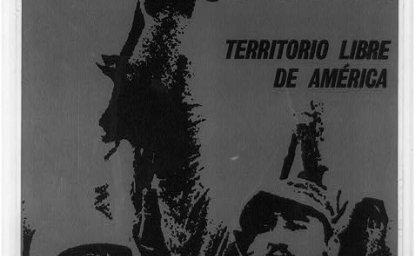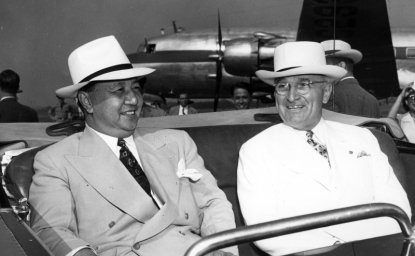The 1953 Coup D’Etat in Iran: New FRUS, New Questions
Gregory Brew explains how the latest FRUS volume on the 1953 coup in Iran reveals the real-time thought processes of US policy-makers during this influential moment in US-Iran relations.

A blog of the History and Public Policy Program
Gregory Brew explains how the latest FRUS volume on the 1953 coup in Iran reveals the real-time thought processes of US policy-makers during this influential moment in US-Iran relations.

The New FRUS Collection Opens Up Fresh Avenues for Research into U.S. Decision-Making
In June 2017, with little fanfare or prior warning, the US State Department’s Office of the Historian released a brand-new volume in its venerable series, Foreign Relations of the United States (FRUS). The volume consisted of 375 documents from 1951 to 1954 relating to the United States and Iran, with a particular focus on Operation TPAJAX, the CIA-sponsored coup d’etat in August 1953 that removed the government of nationalist Prime Minister Mohammed Mossadegh and replaced it with a pro-US regime led by the shah, Mohammed Reza Pahlavi.
An infamous event in the early Cold War, the August ’53 coup marked one of the first times the United States used covert operatives to overthrow a foreign government. It was also one of the first American interventions in the Middle East, and an event which shaped the US-Iranian relationship for decades, generating immense resentment and suspicion that lingers to this day.
As several prominent scholars have already pointed out, the new FRUS doesn’t reveal much about the events of August 1953 that was not already known. It confirms that the coup was the result of CIA operations and agents working in tandem with indigenous Iranian elements. While the new documents provide detail, many are heavily edited or entirely excised. The preface to the volume claims that most operational records of the coup were destroyed. Evidence of British involvement in the coup, which is well-known, is nevertheless nowhere to be found in this volume.
What the new FRUS does show is the inner-workings of the US government during the Truman and Eisenhower eras. It reveals how differing agencies and individuals viewed issues like resource nationalism, post-imperial identity and nascent democracy, all of which were present in Iran. Beyond illustrating how the coup was carried out, the FRUS volume offers further evidence as to why the US government thought such an action necessary.
A major question facing the US was whether Iran would eventually fall under communist influence. Iran possessed a large and organized communist party, the Tudeh, that the US feared might take advantage of Iran’s political instability. Mossadegh’s government, representing a political coalition known as the National Front, had been in power since May 1951, with a single brief hiatus in July 1952. Yet the combination of internal political turmoil and external economic pressure made Mossadegh’s position appear uncertain.
An intelligence estimate drafted in November 1952 predicted that the National Front was unlikely to lose control to the Iranian communist Tudeh Party for the rest of 1953. However, not all within the US government agreed with that assessment. The Ambassador to Iran Loy Henderson, for instance, warned that the paper had a “dark side,” and that the Iranians might do “rash things” if the US did not meet their demands for economic aid. The CIA emphasized the risk that communists in Iran “might gain the ascendancy” if conditions there were allowed to deteriorate. Pressure from the CIA and others resulted in a re-drafting of the November report in January, incorporating these views. The new draft warned of a “gradual assumption of control by Tudeh” as the political situation in Iran grew more unstable. A report in March indicated to the NSC that even without a sudden take-over by the Tudeh, communists could gain control over the government “imperceptibly over a considerable period of time.” This would necessitate action “prior to an identifiable attempted or actual communist seizure of power.”
Ultimately, the fear of a communist take-over in Iran was the main justification for the US decision to overthrow the Mossadegh government. Yet the volume shows that certain officials had been calling for Mossadegh’s removal for months before March 1953, when the decision to remove him was finally made.
The volume contains considerable discussion of the shah, Iran’s monarch. After the coup, the shah would emerge as Iran’s authoritarian ruler and hold on to power, often through brutal means, with US support. Yet during the 1951-1954 crisis, multiple US officials felt the shah was too weak, too indecisive and too unreliable. The documents reveal that the US decided to undertake the coup and remove Mossadegh without the shah’s support if necessary.
Mossadegh, unlike previous prime ministers, was neither a pawn of foreign powers nor an instrument of the shah, but rather a figure who derived his support from the people. The new FRUS volume contains an interesting debate over whether the National Front constituted a “true” democratic revolution. Max W. Thornburg, an influential figure in Iran before 1951, argued that the country was not yet ready for democracy. His doubts concerning the reliability of the Iranian middle-class, who saw Mossadegh as their champion, reflected the notion that supporting an authoritarian regime was the best way of containing communism. Thornburg’s “program” for Iran mirrored, in a number of ways, what the Pahlavi state would attempt after 1953, before it collapsed amidst the 1979 Islamic Revolution.
Thus, while the new FRUS Iran volume doesn’t add as much to the scholarship surrounding the August coup as was perhaps anticipated, it is nevertheless a valuable resource, not only for scholars of US-Iranian relations but for anyone hoping to gain greater insight into how policy-making occurred in the early Cold War.


A global leader in making key archival records accessible and fostering informed analysis, discussion, and debate on foreign policy, past and present. Read more


The Cold War International History Project supports the full and prompt release of historical materials by governments on all sides of the Cold War. Read more


